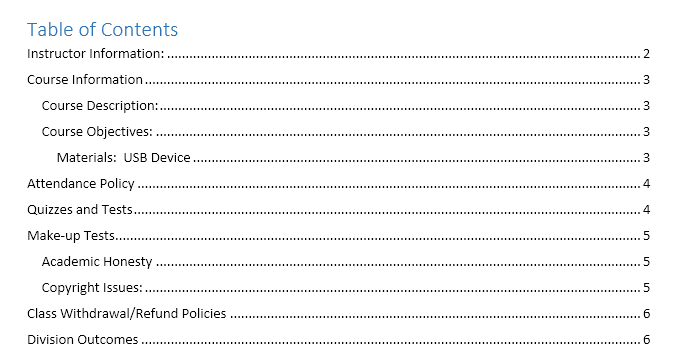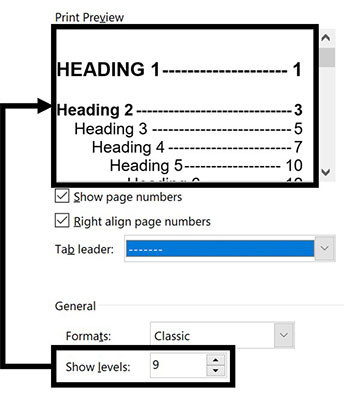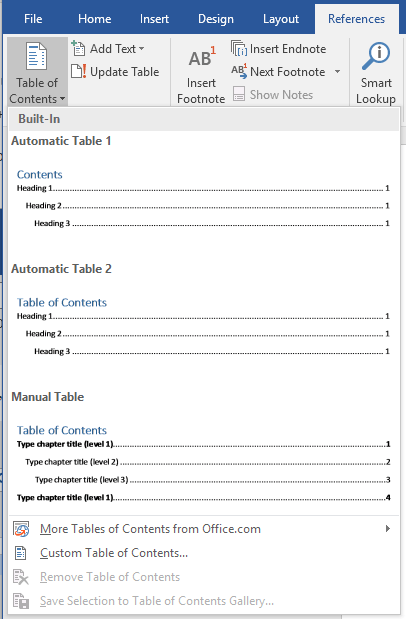
- #Manual table of contents word how to
- #Manual table of contents word generator
- #Manual table of contents word update
Step 1 − Consider you already have a table of content as shown above. The following steps will help you delete an existing Table of Contents from Microsoft Word.

#Manual table of contents word update
Step 2 − If you want to update just the page numbers then select the first option Update page numbers only available in the dialog box but if you want to update page numbers as well, then select the second option Update entire table and you will find your table of content updated with all the latest changes. Click the References tab followed by the Update Table button this will display the Update Table of Contents dialog box with two options. Following are the simple steps to update an existing Table of Contents in your Microsoft Word. When you work on a Word document, then number of pages and their content keep varying and accordingly you need to update your Table of Contents. Now if you press the Ctrl key and then click over the any link available in the table of content, it will take you directly to the associated page. Once done, click the OK button to apply the options. You can turn ON or turn OFF the Show Page Numbers option. If you click on the Insert Table of Content option available in the option menu, then it will show you a dialog box where you can select the number of levels you want to have in your table of content. Step 4 − You can select number of levels of headings in your table of content. A table of content will be inserted at the selected location. Step 3 − Select any of the displayed options by simply clicking on it. So bring your insertion point at the beginning of the document and then click the References tab followed by the Table of Content button this will display a list of Table of Contents options. Step 2 − You can insert a table of content anywhere in the document, but the best place is always at the beginning of the document. Step 1 − Consider a document having different levels of headings. The following will help you to create Table of Contents in your Microsoft Word using various levels of headings. A table of content helps in navigating through a Word document by providing associated page numbers and direct links to various headings available on those pages.
#Manual table of contents word how to
Let us learn how to create a Table of Contents. You can set a list of headings which should be a part of the table of contents. A table of contents (or TOC) is a list of headings in the order in which they appear in the document. In your actual document, you’ll have paragraphs of text between each Chapter and Subheading.In this chapter, we will discuss how to create table of contents in Word 2010.

In the screenshots, the text is omitted for simplicity.

Remember, you’re applying these styles to your actual document, not to a manually created table of contents you may already have. If your document has sub-headings, select the first one and repeat the steps above, this time choosing “Heading 2.” Repeat these steps as necessary and you’ll end up with something like the screenshot below. In this case, select the desired heading style directly or click the small downward facing arrow at the bottom of the list to expand all of the styles options. Note that if your Word window is wide enough, you may see the style options listed directly in the toolbar instead of the “Styles” button. In the drop-down list that appears, select “Heading 1” to define your selected text as the first primary heading. Next, head up to the Word toolbar (or the “Ribbon,” as Microsoft so adorably named it) and, from the Home tab, click the Styles button. To start off, select your first chapter or heading by highlighting it in your document. Therefore, the first step to automatically generating a table of contents is to make sure that your document has the appropriate styles applied.
#Manual table of contents word generator
Microsoft Word’s automatic table of contents generator relies on styles, which are special formats you apply to your document so that Word knows which parts of your text are headings, subheadings, paragraphs, and so on.


 0 kommentar(er)
0 kommentar(er)
